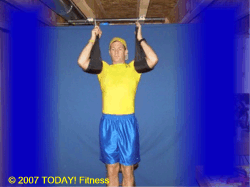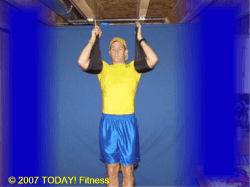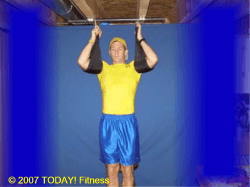|
Fitness
Travel Tips |
|
Unless your travel is purely
for vacation (including a vacation from training) there is really no
reason why you should let yourself off the hook and scale back.
Occasional time off from intense training is sometimes beneficial and
necessary to let your body recover and rejuvenate completely from chronic
training stress. However, it is also true that it really doesn't
take much to maintain fitness once it is developed, and an abbreviated,
but still effective, workout routine could certainly be used, if you
choose, when you're on the road.
That being said, I wanted to
share some tips I ran across that focus on staying in shape and eating
right while traveling. If you are indeed serious about your health
and fitness, find reasons to better your situation, rather than excuses to
take a break!
Decide to improve while
you're traveling and to come home in better shape than when you left.
The only reason most people usually come home with lower fitness and a
few extra pounds than when they left is because they didn't make a
decision to do otherwise. Most people hold a belief that it's
"impossible" to stay on their eating and exercise program while they are
traveling. Why not get in better shape no matter where you are?
Write out your workout
schedule in advance. In addition to writing out goals regularly,
you should also commit your training schedule to paper and especially when
you are traveling. Write down the days, the time of the day, and the
exact workout you plan to do and you will be amazed at how easy you will
find it is to get to the gym and have great workouts.
Get a hotel with a
kitchen. If you don't have a kitchen, you will be much more
likely to skip meals, and it is very difficult to eat 5 or 6 meals a day
(as recommended by any good fat burning or muscle building nutrition
program). You don't want to end up at the mercy of restaurant,
hotel, or convenience store food.
Go food shopping
immediately after checking in. It also helps to have a grocery
list of what meals you plan to make. This places you in control of
the choices that you make for meals.
Check the local
restaurant locations and menus and commit in advance to making healthy
choices when dining out. Get in the habit of scoping out
restaurants in advance and even check their websites. Make a
decision in advance whether you are going to have a regular meal or a
"cheat meal". If it's a cheat meal, enjoy whatever you want, but
keep the portion size in mind. Consider sharing that piece of
cheesecake rather than acting on impulse and complaining about it later.
Cook portable foods and
bring meal replacements or healthy snacks for drives, flights and day
trips. Healthy sandwiches, tuna burgers, oatmeal pancakes,
fruit... there are a variety of things that you can make or buy and bring
on the road with you.
Choose your gym or check
your hotel fitness facilities in advance. Many people workout
right in their hotel room with
body weight exercises, or portable
equipment. If you prefer the equipment in a gym, look for a hotel
that offers a fitness center, or an affiliation with a local gym.
Pack your workout gear
and plenty of workout clothes. When you are in a hurry, it's
easy to forget to pack your workout clothes. Depending on your plan
of action, remember to pack what you need for the workout that you are
intending to do (ie. straps, lifting belts, etc..)
Change up your workouts
as you change up your gym. Some people get accustomed to their
hometown gym and are often upset or disappointed when they don't have
access to the same equipment when they travel. This can be a
blessing in disguise. Your body adapts to any workout, often in just
a matter of weeks. Sometimes a simple change of exercises is enough
to stimulate new progress.
Walk, bike, or make
physical recreation part of your travel plans. When you are on
the road for business or pleasure, there are usually plenty of
opportunities to get some physical recreation and see the sites by foot.
Hiking, biking, sightseeing... find a healthy way to keep your blood
pumping.
|
|
Pay Attention to
Pain and Soreness |
|
When any workout or specific
exercise causes you pain, pay attention. Knowing how to
react can help you avoid a serious injury. Strength training
can cause several types of pain including:
Muscle
Soreness
When you use muscles you have not used for a while or try a
new exercise or training technique, it is normal to feel a
dull ache of soreness in the muscles that were trained. This
pain is caused by microscopic tears in the fibers of the
connective tissues in your body, the ligaments that connect
bones to other bones, and the tendons that connect muscles
to bones.
This micro-trauma may sound
harmful but is in fact the natural response of your muscles
when they experience work. This is the primary reason it is
so important that you get enough rest between specific
muscle workouts. Each time you work out with weights, you
cause this "damage" - these tiny tears in your muscles; they
need ample resting time to rebuild and become even stronger,
bigger, and more firm.
Pain
During or Just After a Workout
During a workout, repeated contractions cause lactic and
other acids, as well as proteins and hormones, to build up
in muscle tissue. This can cause pain even without injury.
But if you experience a sharp, continuous pain, or pain
accompanied by a burning sensation, stop lifting and get it
checked.
Cramps
These happen when muscles, often in the calves or feet, knot
up in intense contractions. Cramps occur most commonly in
endurance sports like cycling and running, where the athlete
loses a lot of fluids through sweating. This is why it's
very important to stay well-hydrated during exercise. If you
do get cramps, the best way to stop them is to gently
stretch the cramped muscle.
Injury
When working out with weights you need to be in full control
of both the weights and your own body as it lifts and uses
the weights. Careless weightlifting can result in injury.
Not warming up, attempting to lift too heavy a weight, using
momentum or jerky movements, letting the weights drop, not
using correct form, or forgetting to stretch or cool-down
after your workout can indeed result in injury.
Strength training provides
many important benefits that cannot be achieved by any other
exercise or activity. However, when enjoying this great form
of exercise, be sure to pay attention to pain and soreness
so that your program is not only effective, but safe as
well. Good luck: I hope you enjoy all the wonderful benefits
of a safe and effective strength training program.
ref: thestretchinghandbook.com |
|

|
|
|
Elite
Bodyweight Exercise of the Month! |
|
Hanging Ab
Crunch

Summary:
This is one of my favorite bodyweight abdominal exercises and
one that I try perform on a regular basis. Because there are
several variations, beginners and advanced alike can benefit
from the excellent ab work. Although you can
perform this exercise simply by hanging
by your hands, the
Ab Slings that are depicted in the pictures allow you to
perform more repetitions of the exercise since they take hand
fatigue out of the equation.
Target:
abdominals (rectus
abdominus)
Count:
2 count
Description:
Beginners should
raise their knees 90 degrees until their thighs are parallel
with the floor, while intermediates would continue past this
point and attempt to touch their knees to their elbows (or as
far as they can past 90 degrees). For the advanced
variation of the exercise the goal should be to touch your
ankles or feet to the bar.
 
|
|
Success Story |
|
When it comes to health and
fitness you can always find people that work out… and people
that don’t. Since I became a personal trainer, I hear
all kinds of stories about people’s challenges and
successes. I wanted to share one with you from a
friend and colleague of mine that
inspires me to stick to it:
Why I Exercise – by Michael
Spalding
To understand why I exercise, let me give you some
background so you get a better picture, without revealing my
age at this point.
I grew up as a skinny kid in
New Jersey, graduating at a whopping 132 pounds.
Several years later
I started playing music and then traveling to
do so. I was eating all the best food any vending
machine could provide (nothing like some yo-ho’s at 3am in
the morning). After many years, one day my metabolism
just seemed to stop. I knew that because I could no
longer wear my favorite jeans and at the time I thought they
had shrunk. Well, they didn’t, but I thought nothing
of it since I was young.
Fast forward several more
years… We had a family reunion one year and I was wearing
these very awful looking shorts. Afterwards I saw a
picture of what my family saw…
this out of shape, large guy… ME! My wife started
nagging me to go to a gym and do something because I was
complaining about my back hurting. I blamed that on
the many years of lifting music equipment. I caved in
and went to the gym, maybe 1 to 2 days a week… nothing very
serious. Nothing really changed for me… same large
guy. I had gone from a skinny 132 pound high school
grad to an out of shape 190+ pounder.
Fast forward a couple more
years… My son was born and it was great. But the sad
thing was that the older he got, the harder it was for me to
pick him up because of my back pain. When he was 5, I
was 45, and not even strong enough to really pick up my son.
At about the same time some of my friends (who where my same
age) started having serious issues. There were two
heart attacks, a stroke, breathing problems… enough to wake
me up. I made a decision that this was not going to
happen to me.
I found that fat picture of
me, the one from the family reunion. I stuck it up on
my bathroom mirror. I started going to the gym 3 days
a week, even though I really didn’t know what I was doing.
I roamed around from machine to machine and did some cardio
stuff… but nothing very serious. One thing did happen
though… my back slowly stopped hurting! This was after
about a year.
Fast forward a couple more
years… I picked up a routine after I started doing research
on technique and how to get the most out of a three day
workout plan. One day my wife noticed when I was
playing with our son and flinging him in the air. She
said “wow, I had no idea you could do that”. I said
“what?” She said “pick him up”. We smiled and
another thought struck me… what if I did a four day routine?
Well, here we are many years
since… I went up to a 5 day routine, including cardio every
day along with the weights. I dropped from that 190+
pound guy, to roughly 175 pounds (give or take). My
son is now almost 17 years old and I have been working out
on a 4 or 5 day routine for about 10 years. I feel
better now than I did when I was 20. There is nothing really
that I feel I can not do (which is a great feeling when you
keep up with the 20 year oldsJ).
I am a believer in using heavy
weights to achieve strength rather than looks. I
typically perform 10-12 exercises per day with 4 sets of 10
reps for each exercise with 40 minutes of cardio each
workout day. I also still keep my fat picture on the mirror
as my daily motivation!
In case you were a little slow
with the math, my friend Mike here is pushing 57 years old!
(Sorry Mike, I had to come right out with it since I find
that very impressive) Mike tells me that he is using
50 lbs for seated dumbbell curls, does 270 lbs for lat
pull-downs, and he is putting up 315 lbs on the bench press!
I don’t know about the rest of you, but I will be extremely
happy with myself if I could come close to that in a few
years! I think that a common pitfall with people
nowadays is deciding when it is ok to stop working out.
At what age is the excuse acceptable? The bottom line
is that the same principals apply to working out at any age.
Do as much as you can handle, challenge yourself to improve,
and you will continue to see the benefits!
|
|
It's
Go Time! |
|
The end of
October marks the beginning of the danger zone for a lot of
people! Now you have the Halloween candy to deal with,
followed by the huge portions during the feasts at
Thanksgiving (not to mention the leftovers) and then you
have Christmas the following month with the dinners, candy,
treats, etc... and a week later, we finish up with New Years
and the related celebrations. That could be quite a
damaging season... if you let it!
Be
prepared... don't wait until your New Year's resolution to
start being good. If you eat healthy and workout all
throughout the season you will have that much less ground to
make up when you "decide to get back into it". I'm not
saying that you should stick to salads instead of that
turkey dinner, but if you are smart about your choices on
most of the other days, then you will be in a much better
position by 2008!
If you want
to drop a few inches, don't fall for the quick wait loss
promises. One to two pounds per week is a recommended
goal to safely lose weight and it takes about 12 weeks after
starting an exercise program to see measurable changes in
your body. Do the math and plan accordingly when
setting your weight loss goals.
For prior issues of this
newsletter go to
www.todayfitness.net/news.
Good Luck!
Pete
Mazzeo, CPT
pmazzeo@todayfitness.net
"Every worthwhile accomplishment has a price tag
attached to it. The question is always whether you are
willing to pay the price to attain it" | |